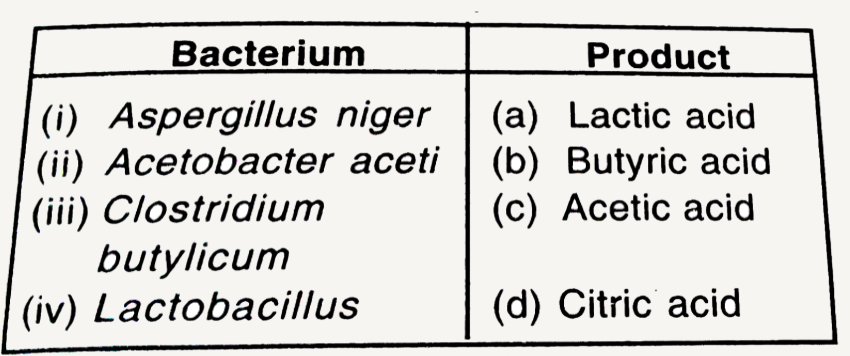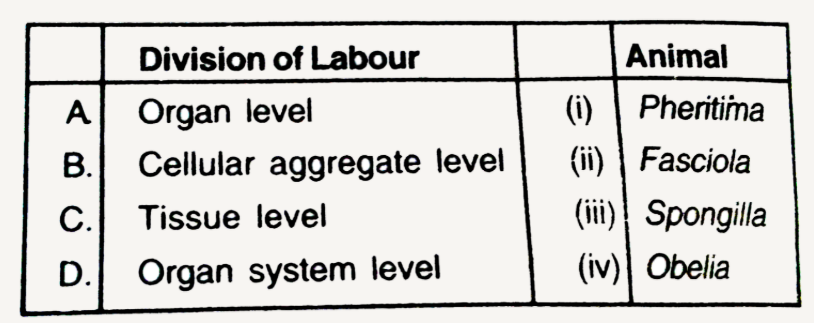Match the following lists:

The correct Answer is:a top;btop,s;ctop,r;dtoq,s

From the figure ,ΔABC is equilateral. Hence,
tan60∘=k
i.e., k=√3 (for first quadrant)
or k=−√3 (for fourth quadrant)
then the possible coordinates are (1,±√3).
Similarly , for the second quadrant, the point is (−1,√3) and for the third quadrant , the point is (−1,−√3).
(b) Case i :
If OA=AB, then ∠A=30∘, Therefore

∠AOB=75∘
∴AMOM=tan75∘
AM=OMtan75∘
k=1×(2+√3)
∴k=2+√3
Hence, point A is (1,2+√3). By symmetry, all possible points are (±1,±(2+√3)).
Case ii:
AO=OB
∴∠AOB=120∘

AM=2sin60∘=√3
and OM=2cos60∘=1
Hence, point A is (−1,−√3), By symmetry, all possible points are (±1,±√3).
(c). 
Let ∠DOB=∠ABM=θ.
Area of ΔOAB=12×OB×AM=12×2√3
or 2×2sinθ=2√3
or sinθ=√32
or AM=√3andBM=1
Hence, A has coordinates (3,√3), By symmetry, all the possible coordinates are (±3,±√3).

From the figure, A has coordinates (1,√3).
By symmetry, all possible coordinates are (±,±√3).
(d) 
OB=2units=OO'=Radius
or OM=22=1unit
In ΔOO'M,
O'M=√4−1=√3
Since ΔOAB is isosceles, point A lies on the perpendicular bisector of OB. Therefore,
AM=√3+2=OM+OA
Hence, the coordinates of A will be (1,2+√3) in the first quadrant. By symmetry, all possible coordinates of A are (±1,±(2+√3).
Topper's Solved these Questions
- COORDINATE SYSYEM BOOK - CENGAGE ENGLISHCHAPTER - COORDINATE SYSYEM EXERCISE - Numerical value
12 Videos
- COORDINATE SYSYEM BOOK - CENGAGE ENGLISHCHAPTER - COORDINATE SYSYEM EXERCISE - JEE Main
6 Videos
- COORDINATE SYSYEM BOOK - CENGAGE ENGLISHCHAPTER - COORDINATE SYSYEM EXERCISE - Linked
10 Videos
- COORDINATE SYSTEMBOOK - CENGAGE ENGLISHCHAPTER - COORDINATE SYSTEMEXERCISE - Multiple Correct Answers Type
2 Videos
- CROSS PRODUCTS BOOK - CENGAGE ENGLISHCHAPTER - CROSS PRODUCTS EXERCISE - DPP 2.2
13 Videos
Similar Questions
Knowledge Check
Match the following list of bacteria and their commercially important products.
BacteriumProduct(i)Aspergillus niger(A)Lactic acid(ii)Acetobacter aceti(B)Butyric acid(iii)Clostridium butylicum(C)Acetic acid(iv)Lactobacillus(D)Citric acid
Choose the correct match.Ai−(B),ii−(C),iii−(D),iv−(A)Bi−(B),ii−(D),iii−(C),iv−(A)Ci−(D),ii−(C),iii−(B),iv−(A)Di−(D),ii−(A),iii−(C),−iv−(B)
Match the following list of bioactive sub- stances and their roles
Choose the correct match

View SolutionMatch the following list of bacteria and their commercially important products
Choose the correct match

View SolutionMatch the following list of animals with their level of organisation :

Choose the correct match showing division of labour with animals.
View SolutionMatch the following list of animals with their level of organisation.
Choose the correct match sryowing division of labour with animal example.

View SolutionMatch the following list of animals with their level of organisation.
Division of LabourAnimalA.Organ leveli.PheretimaB.Cellular aggregate levelii.FasciolaC.Tissue leveliii.SpongillaD.Organ system leveliv.Obelia
Choose the correct match showing division of labour with animal example.
View SolutionMatch the following list of bioactive substances and their roles.
Bioactive substanceRole(i)Statin(A)Removal of oil stains(ii)CyclosporinA(B)Removal of clots from blood vessels(iii)Streptokinase(C)Lowering of blood cholesterol(iv)Lipase(D)Immuno-suppressive agent
Choose the correct match.
View SolutionMatch the following list of bacteria and their commercially important products.
BacteriumProduct(i)Aspergillus niger(A)Lactic acid(ii)Acetobacter aceti(B)Butyric acid(iii)Clostridium butylicum(C)Acetic acid(iv)Lactobacillus(D)Citric acid
Choose the correct match.
View Solution


